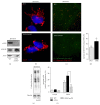S-Nitrosoglutathione Reductase Plays Opposite Roles in SH-SY5Y Models of Parkinson's Disease and Amyotrophic Lateral Sclerosis
- PMID: 26491229
- PMCID: PMC4600557
- DOI: 10.1155/2015/536238
S-Nitrosoglutathione Reductase Plays Opposite Roles in SH-SY5Y Models of Parkinson's Disease and Amyotrophic Lateral Sclerosis
Abstract
Oxidative and nitrosative stresses have been reported as detrimental phenomena concurring to the onset of several neurodegenerative diseases. Here we reported that the ectopic modulation of the denitrosylating enzyme S-nitrosoglutathione reductase (GSNOR) differently impinges on the phenotype of two SH-SY5Y-based in vitro models of neurodegeneration, namely, Parkinson's disease (PD) and familial amyotrophic lateral sclerosis (fALS). In particular, we provide evidence that GSNOR-knocking down protects SH-SY5Y against PD toxins, while, by contrast, its upregulation is required for G93A-SOD1 expressing cells resistance to NO-releasing drugs. Although completely opposite, both conditions are characterized by Nrf2 localization in the nuclear compartment: in the first case induced by GSNOR silencing, while in the second one underlying the antinitrosative response. Overall, our results demonstrate that GSNOR expression has different effect on neuronal viability in dependence on the stimulus applied and suggest that GSNOR could be a responsive gene downstream of Nrf2 activation.
Figures








Similar articles
-
Dimethyl fumarate attenuates 6-OHDA-induced neurotoxicity in SH-SY5Y cells and in animal model of Parkinson's disease by enhancing Nrf2 activity.Neuroscience. 2015 Feb 12;286:131-40. doi: 10.1016/j.neuroscience.2014.11.047. Epub 2014 Nov 29. Neuroscience. 2015. PMID: 25449120
-
Naringenin protects against 6-OHDA-induced neurotoxicity via activation of the Nrf2/ARE signaling pathway.Neuropharmacology. 2014 Apr;79:380-8. doi: 10.1016/j.neuropharm.2013.11.026. Epub 2013 Dec 11. Neuropharmacology. 2014. PMID: 24333330
-
O-Aminobenzoyl-S-nitrosoglutathione: A fluorogenic, cell permeable, pseudo-substrate for S-nitrosoglutathione reductase.Free Radic Biol Med. 2017 Jul;108:445-451. doi: 10.1016/j.freeradbiomed.2017.04.008. Epub 2017 Apr 15. Free Radic Biol Med. 2017. PMID: 28419866
-
Copper homeostasis and neurodegenerative disorders (Alzheimer's, prion, and Parkinson's diseases and amyotrophic lateral sclerosis).Chem Rev. 2006 Jun;106(6):1995-2044. doi: 10.1021/cr040410w. Chem Rev. 2006. PMID: 16771441 Review. No abstract available.
-
Mitochondria and neurodegeneration.Biosci Rep. 2007 Jun;27(1-3):87-104. doi: 10.1007/s10540-007-9038-z. Biosci Rep. 2007. PMID: 17486441 Review.
Cited by
-
Cysteine Modifications in the Pathogenesis of ALS.Front Mol Neurosci. 2017 Jan 23;10:5. doi: 10.3389/fnmol.2017.00005. eCollection 2017. Front Mol Neurosci. 2017. PMID: 28167899 Free PMC article. Review.
-
Redox activation of ATM enhances GSNOR translation to sustain mitophagy and tolerance to oxidative stress.EMBO Rep. 2021 Jan 7;22(1):e50500. doi: 10.15252/embr.202050500. Epub 2020 Nov 27. EMBO Rep. 2021. PMID: 33245190 Free PMC article.
-
Fifty-Hertz Magnetic Field Affects the Epigenetic Modulation of the miR-34b/c in Neuronal Cells.Mol Neurobiol. 2018 Jul;55(7):5698-5714. doi: 10.1007/s12035-017-0791-0. Epub 2017 Oct 16. Mol Neurobiol. 2018. PMID: 29039021
-
Naturally Derived Polyphenols Protect Against Corticosterone-Induced Changes in Primary Cortical Neurons.Int J Neuropsychopharmacol. 2019 Dec 1;22(12):765-777. doi: 10.1093/ijnp/pyz052. Int J Neuropsychopharmacol. 2019. PMID: 31812985 Free PMC article.
-
The role of S-nitrosoglutathione reductase (GSNOR) in human disease and therapy.Crit Rev Biochem Mol Biol. 2017 Jun;52(3):340-354. doi: 10.1080/10409238.2017.1304353. Epub 2017 Apr 10. Crit Rev Biochem Mol Biol. 2017. PMID: 28393572 Free PMC article. Review.
References
Publication types
MeSH terms
Substances
LinkOut - more resources
Full Text Sources
Other Literature Sources
Medical
Miscellaneous

